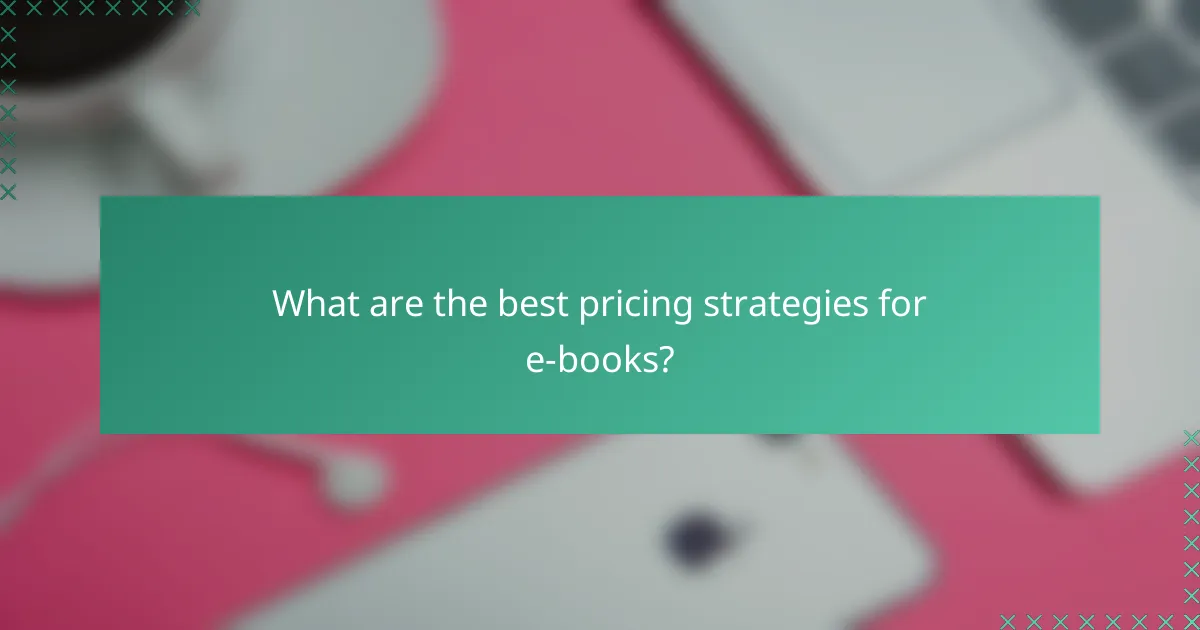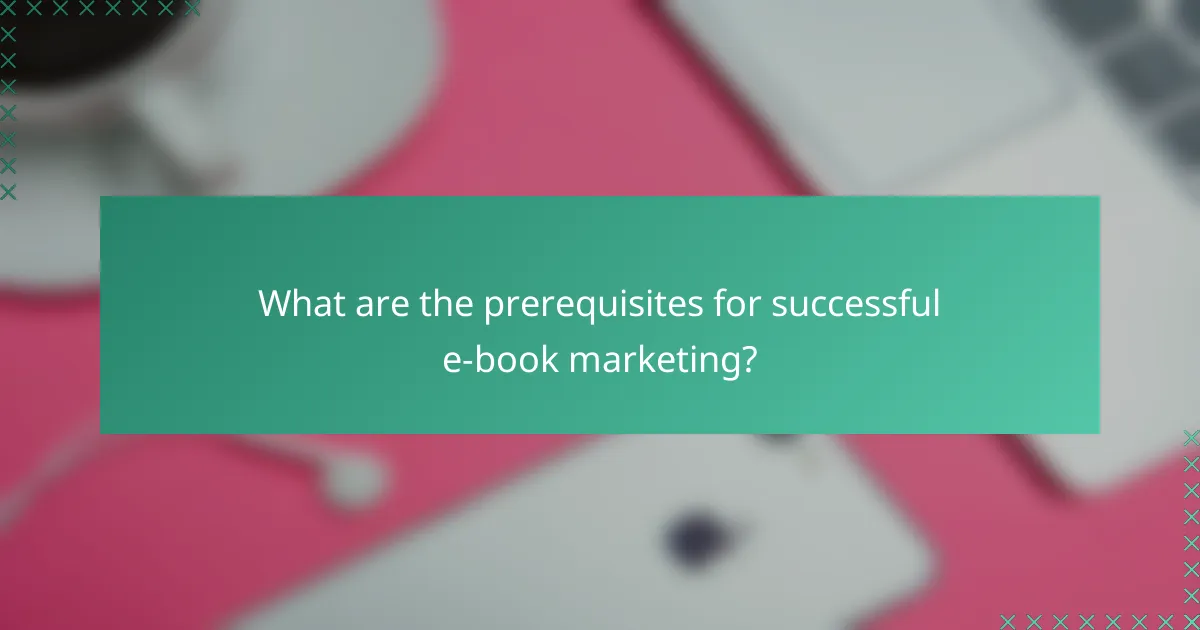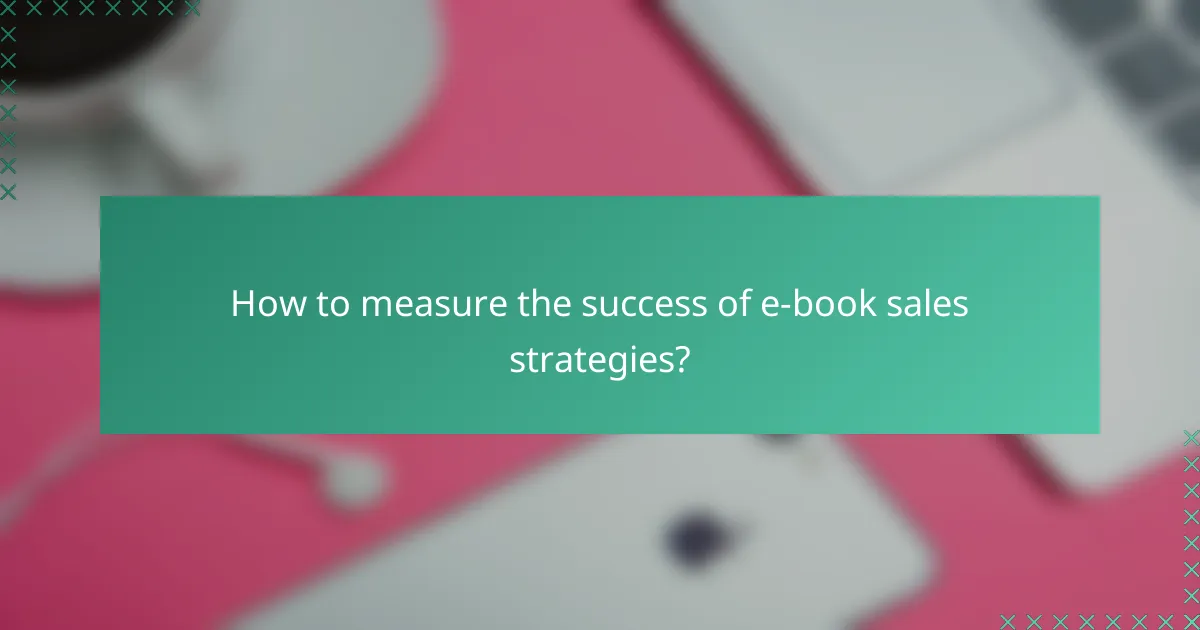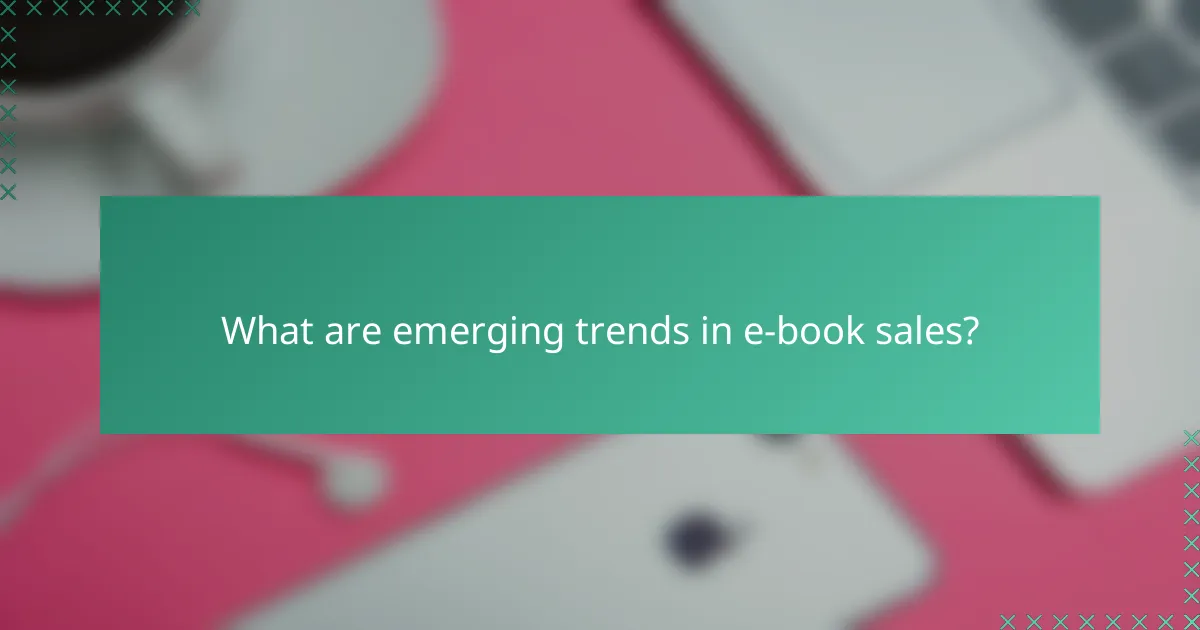In the competitive world of e-books, mastering upselling techniques, pricing strategies, and audience targeting is crucial for success. By enhancing the value of your primary offerings and understanding market dynamics, you can effectively increase sales and customer satisfaction. Additionally, identifying and engaging your target audience through tailored marketing strategies ensures that your e-books resonate with the right readers.

How to effectively upsell e-books?
To effectively upsell e-books, focus on enhancing the value of your primary offering by presenting complementary products or exclusive content. This approach not only increases average order value but also enriches the customer experience.
Bundling e-books with related products
Bundling e-books with related products, such as workbooks, audiobooks, or online courses, can significantly boost sales. By offering these items together at a discounted rate, you create a compelling package that appeals to customers looking for comprehensive solutions.
For example, if you sell a cookbook e-book, consider bundling it with a meal planning guide or a set of recipe cards. This strategy can increase perceived value and encourage customers to purchase more than they initially intended.
Offering exclusive content upgrades
Exclusive content upgrades, such as bonus chapters, additional resources, or access to a private community, can entice customers to buy more. These upgrades should align closely with the main e-book content to ensure they enhance the overall experience.
For instance, an e-book on digital marketing could offer a free checklist or a video tutorial as an upgrade. This not only incentivizes the purchase but also fosters customer loyalty by providing ongoing value.
Implementing tiered pricing models
Tiered pricing models allow you to offer different levels of content at varying price points, catering to diverse customer needs. This strategy can help capture a wider audience by providing options that fit different budgets and preferences.
Consider offering a basic version of your e-book at a lower price, while a premium version includes additional features like interactive content or one-on-one consultations. This approach can lead to increased sales as customers may opt for higher tiers when they see the added value.
Utilizing email marketing for upsells
Email marketing is a powerful tool for upselling e-books, as it allows you to reach customers directly with tailored offers. By segmenting your email list based on previous purchases or interests, you can send personalized recommendations that resonate with specific audiences.
For example, if a customer bought a fiction e-book, you could follow up with an email promoting a related series or a special discount on a new release. This targeted approach can significantly enhance conversion rates.
Leveraging social proof and testimonials
Social proof, such as customer testimonials and reviews, can effectively encourage upsells by building trust and credibility. When potential buyers see positive feedback from others, they are more likely to feel confident in their purchasing decisions.
Incorporate testimonials prominently on your sales pages and in marketing materials. Highlighting success stories or user experiences can create a sense of community and motivate customers to explore additional e-books or related products.

What are the best pricing strategies for e-books?
The best pricing strategies for e-books involve understanding market demand, consumer psychology, and competitive positioning. Effective approaches can maximize sales while ensuring customer satisfaction and loyalty.
Dynamic pricing based on demand
Dynamic pricing adjusts e-book prices based on real-time demand and market conditions. This strategy allows authors and publishers to capitalize on trends, such as seasonal spikes or promotional events, by raising prices during high demand and lowering them when interest wanes.
For example, an e-book might be priced at $9.99 during its launch week but increase to $14.99 if it gains popularity. Monitoring sales data and market trends is crucial for implementing this strategy effectively.
Psychological pricing techniques
Psychological pricing techniques leverage consumer behavior to influence purchasing decisions. Common tactics include setting prices just below a round number, such as $9.99 instead of $10.00, which can make the price seem significantly lower.
Another approach is to offer tiered pricing for different formats, such as a standard e-book at $9.99 and a deluxe version at $14.99. This not only creates perceived value but also encourages upselling.
Subscription models for e-book access
Subscription models provide readers with access to a library of e-books for a monthly fee, appealing to avid readers. Services like Kindle Unlimited or Scribd allow users to explore various titles without purchasing each one individually.
When considering this model, pricing should reflect the value of the content offered. A monthly fee ranging from $9.99 to $14.99 can be attractive if the selection is diverse and regularly updated.
Discount strategies for first-time buyers
Offering discounts to first-time buyers can incentivize purchases and build a customer base. A common approach is to provide a 20-30% discount on the first e-book purchase, encouraging readers to try out new authors or genres.
Additionally, bundling e-books at a discounted rate can attract new customers. For instance, offering three titles for the price of two can enhance perceived value and encourage bulk purchases.

How to target the right audience for e-books?
Targeting the right audience for e-books involves understanding who your potential readers are and what they seek. By identifying demographics, utilizing analytics, and creating tailored marketing strategies, you can effectively reach and engage your ideal customers.
Identifying reader demographics
Understanding reader demographics is crucial for effective e-book marketing. Consider factors such as age, gender, location, and interests. For example, a romance e-book may appeal more to women aged 18-35, while a technical manual might attract professionals in their 30s and 40s.
Gathering this data can be done through surveys, social media insights, and website analytics. This information helps in crafting targeted messages that resonate with specific groups.
Utilizing social media analytics
Social media platforms provide valuable analytics that can help identify your audience’s preferences and behaviors. Tools like Facebook Insights or Twitter Analytics can reveal which demographics engage most with your content. This data can inform your e-book marketing strategies.
Focus on engagement metrics such as likes, shares, and comments to gauge interest levels. Adjust your content and promotional efforts based on these insights to better connect with your audience.
Creating buyer personas for marketing
Creating buyer personas involves developing detailed profiles of your ideal readers based on demographic data and behavioral insights. These personas should include information like reading habits, preferred genres, and purchasing motivations.
For instance, a persona for a self-help e-book might include a middle-aged individual seeking personal growth, who prefers digital formats for convenience. Use these personas to tailor your marketing messages and product offerings.
Segmenting email lists for targeted campaigns
Segmenting your email lists allows for more personalized communication with your audience. By categorizing subscribers based on their interests or demographics, you can send targeted campaigns that are more likely to convert.
For example, if you have a list of readers interested in science fiction, you can promote new releases in that genre specifically to them. This approach increases engagement and improves the chances of sales.

What are the prerequisites for successful e-book marketing?
Successful e-book marketing requires a clear understanding of your target audience, effective pricing strategies, and the ability to adapt to market trends. Establishing these prerequisites can significantly enhance your chances of reaching potential readers and maximizing sales.
Understanding market trends
To effectively market your e-book, you must stay informed about current market trends. This includes recognizing popular genres, emerging topics, and shifts in reader preferences. For instance, if self-help books are gaining traction, consider how your e-book might fit into that category.
Monitoring platforms like Amazon or Goodreads can provide insights into what readers are currently enjoying. Additionally, social media trends and book review blogs can reveal valuable information about what themes resonate with audiences. Regularly engaging with these sources will help you adjust your marketing strategies accordingly.
Researching competitor pricing
Understanding how competitors price their e-books is crucial for setting your own pricing strategy. Analyze similar titles in your genre to determine a competitive price range. Most e-books typically fall between $2.99 and $9.99, depending on factors like length, content quality, and author reputation.
Consider offering introductory pricing or discounts to attract initial readers. Tools like price tracking websites can help you monitor competitor pricing changes, enabling you to adjust your strategy in real time. Avoid pricing your e-book too low, as this can devalue your work and impact perceived quality.

How to measure the success of e-book sales strategies?
Measuring the success of e-book sales strategies involves analyzing sales data, customer feedback, and market trends. Key metrics include sales volume, revenue growth, and customer satisfaction, which provide insights into the effectiveness of your pricing and marketing efforts.
Analyzing sales data and metrics
To effectively analyze sales data, focus on key performance indicators (KPIs) such as total sales, conversion rates, and average order value. Tracking these metrics over time helps identify trends and patterns in customer behavior, allowing for informed adjustments to your sales strategies.
Utilize tools like Google Analytics or e-commerce platforms that offer built-in reporting features. Regularly review your sales data to spot seasonal fluctuations or the impact of specific marketing campaigns, which can guide future promotions and pricing adjustments.
Gathering customer feedback and reviews
Customer feedback is crucial for evaluating the success of your e-book sales strategies. Encourage readers to leave reviews and ratings on platforms like Amazon or your own website, as these insights can reveal strengths and weaknesses in your content and marketing approach.
Consider conducting surveys or using social media polls to gather direct input from your audience. Analyze this feedback to identify common themes, such as preferred pricing or desired content topics, which can inform your future e-book offerings and promotional tactics.

What are emerging trends in e-book sales?
Emerging trends in e-book sales include the rise of interactive formats, personalized marketing strategies, and subscription models. These trends reflect changing consumer preferences and technological advancements that enhance reader engagement and accessibility.
Growth of interactive e-books
Interactive e-books are gaining popularity as they offer readers a more engaging experience compared to traditional formats. These e-books often include multimedia elements such as videos, quizzes, and hyperlinks that allow for a deeper exploration of content.
When considering interactive e-books, authors and publishers should focus on the target audience’s preferences. For instance, educational e-books can benefit from interactive features that reinforce learning, while fiction may use them to enhance storytelling through visuals and sound.
To successfully implement interactive elements, ensure that they are intuitive and enhance the reading experience rather than distract from it. Testing with a sample audience can provide valuable feedback on usability and engagement before a full launch.
